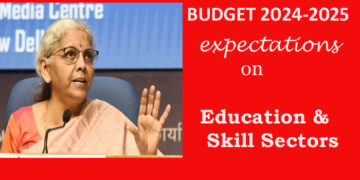The extension and rebranding of the Central Universities Common Entrance Test (CUCET, introduced in 2011) to Common Universities Entrance Test (CUET) and making it as the default entrance test for admissions to Undergraduate programs in all 45 central universities from this academic year (2022-23), perhaps, will have to wait for several years, before it could qualify for being called either as a path breaking reform in easing admission process to higher education institutions in India or an out right disaster. For there are several apprehensions, principally its impact on school education, besides the enormity of the exercise and a further impetus to an already prosperous coaching industry. The bigger challenges of creating more capacity (number of seats) and faculty shortage haven’t been still addressed, which makes it upfront a zero-sum game. Let’s delve into it.
While announcing the revamped CUET on March 21, Prof Mamidala Jagadesh Kumar, chairman University Grants Commission (UGC), was quite upbeat on this new entrance examination as it would lessen financial and mental burden on admission seeking students as multiple entrances will end and there will be more level playing field for rural students and others. This ‘one nation, one entrance test’ will also free resources of indivudal universities and their faculty from stress of conducting own entrance tests. CUET though presently lacks the feature of common counseling, which is crucial to both the choice for students and filling up of seats by universities and affiliated colleges centrally. “Based on the recommendations in the NEP, UGC has brought this national test, which is an important reform in our education system. CUET is mandatory for all central universities and we would like the state and private universities also to come on board and for this we have initiated discussions to persuade them,” Kumar said.
The process for CUET 2022 has already commenced with the examination conducting body, National Testing Agency (NTA) of the Ministry of Education announcing the application dates from April 2-April 30. Exam dates will be in July spread over several days though actual dates are yet to be announced. CUET scores will be used to fill up 1.8 lakh UG seats in 45 central universities and their affiliated colleges. The test will not have any impact on the current reservation and quotas though beneficiaries will have to write CUET. Several deemed universities (central government recognized) have decided to use CUET and in coming days more are expected to join. Private and state universities are still discussing it and may prefer to see the first year performance of the test or using CUET scores to fill the vacant seats after their own process is exhausted.
The computer based CUET scheme as announced currently has three sections—Section I (A) consisting of 13 languages (a student necessarily has to take one), Section I (B) comprises of 20 languages (can be chosen as a subject in addition to mandatory language); Section II offers 27 domain subjects (one can chose upto 6); Section III consist of General Test (only those can opt for this if the their choice of UG program by university demands so). There will be 50 questions each in Section I and Section II to be attempted in 45 minutes each, while as Section III will have 60 questions to be attempted in 60 minutes. The questions will be set on NCERT syllabus of class XII.
The biggest surprise of CUET is that it has binned the board marks as these carry no weightage and anyone who scores pass grade (40%) in boards can write CUET. And experts as well as school leaders are clearly not amused by this. According to Prof Dinesh Singh, former vice-chancellor of Delhi University, who as a revolutionary reformist in capacity of DU VC had not only piloted four-year UG program but worked on a methodology of centrally assessing students through board exams itself (though the scheme was never tested), agrees that in principle the reform (CUET) is good and needed but at the same time, it shouldn’t become another JEE or NEET. “There is a danger that if it follows the same methodology and thought process as of other entrance tests, then it will harm school education to the hilt. One major upshot about these exams (JEE, NEET) over the years has been they have messed up entirely our school education system. Anybody who has seen how students prepare for these entrances knows how little attention they pay to studies, knowledge or creativity. JEE has been a creativity killer,” he told NDTV. Citing abysmal performance in PISA in the past, Prof Singh feels attention is needed to be paid to school education and not kill it. “The design of questions and test should be such as to foster academic and practical scholarship in schools and therefore needs appropriate caution and thinking,” he adds.
The necessity of switching over to a common entrance test has been partly attributed to stem the fierce competition for limited seats among students seeking admissions to colleges. The most generic criterion of admissions is based on marks cut offs obtained from board exams. Over the years, however, the cutoffs have been so high in some DU colleges that even 100% scorers’ get left out. Various school boards have been differentially and generously in their marking resulting in anomalies by different school boards and putting some students at advantageous position. Obtaining high marks was also putting lot of pressure on school ecosystem and stakeholders including students, parents, teachers, schools and even examiners. That was a big reason for fight against board exams and a rationale for keeping their weightage aside. But now with marks no longer needed as until now, there is a fear that coaching centres/ platforms for CUET will mushroom and overtake classroom studies. It will be like curing one disease but causing another with the treatment. So, to make it work, CUET setters and schools will have ensure classroom interest in the schools. “I agree, this is going to be a big challenge for schools. But at the same time, it is too early to pronounce a judgment as I am confident we will find a way to remain relevant to students. My optimism comes from the changed exam pattern of CBSE, which discourages rote learning and emphasizes out of box thinking on part of students to answer questions. Other boards too are or will follow to promote creative thinking. So, our teachers will have to change the old ways of teaching and if we can add CUET preparation subtly, I don’t think school education will lose out,” says Vividh Gupta, Principal of Bal Bhavan Public School, Mayur Vihar (Delhi).
Indeed this is a big reform, but where does it lead to country’s all important education system, will be known only after the process passes the teething problem period, scrutiny and provides evidence of its success.
Prof Ali Raza Moosvi, Dean of Earth Sciences at Karnataka Central University in a recent newspaper (TOI) article has raised the issues of university autonomy and its unique character, traditional catchment ground of students, and sheer magnitude of the exercise seeking approval from university statuary bodies and authorities—all three having been voiced in response to a proposed move of merging all central university acts into one in 2013. As per him, these issues remain valid even today.
Exam stress has been a vociferous perennial issue in India and time and again policy makers have been experimenting with ways to reduce exam-related stress in students. For instance, CBSE has switched over to semester pattern instead of singe annual examination. But in reality, from unit tests to pre-boards, boards and now CUET in addition to JEE, NEET, CLAT, CAT and others, it is year round examination carnival at the end of the day. So, all this needs a deep charcha (discussion) and a solution that achieves the national goals of education alongside SDG 4 besides achieving set targets of GER in higher education. Raising quality of both school as well as higher education, making education system conducive to holistic development and harnessing potential of all children in India must guide thinking on this issue.
By Autar Nehru













